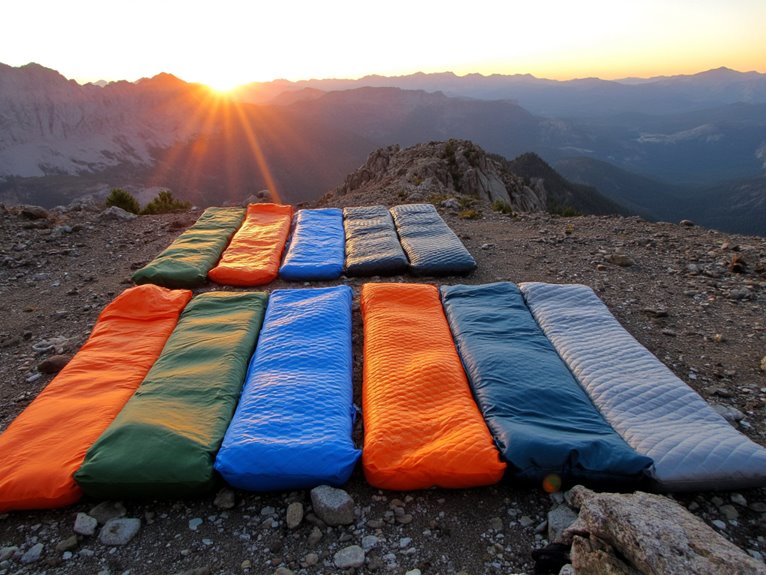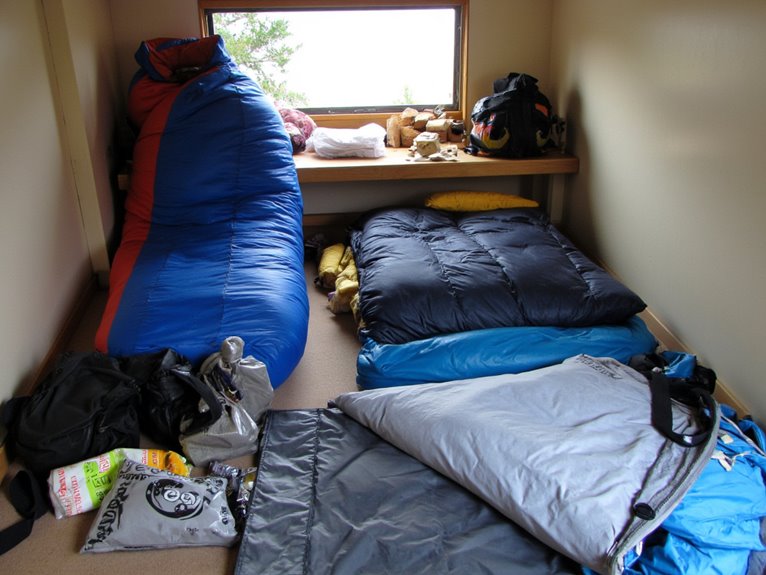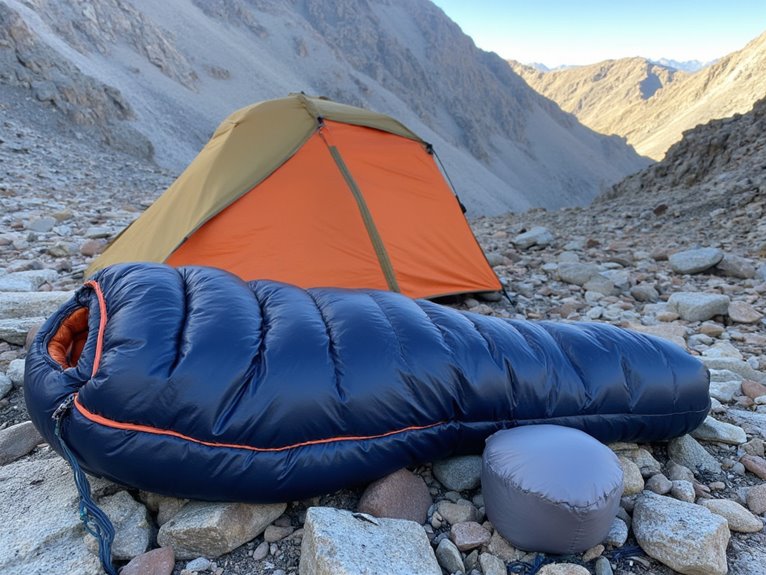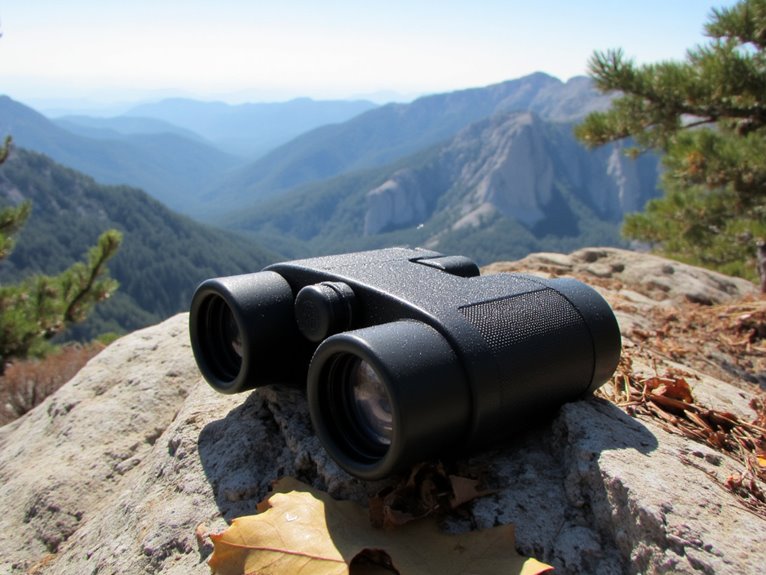10 Best Ultralight Backpacking Sleeping Pads for Maximum Comfort and Minimal Weight
I’ve tested dozens of ultralight sleeping pads over thousands of trail miles, and these models excel for weight-conscious backpackers. Top performers include the Therm-a-Rest NeoAir Xlite NXT at 13 ounces, KLYMIT Static V2 at 20 ounces with V-Chamber side sleeper support, and Gear Doctors ApolloAir offering 5.2 R-value at just 17 ounces. Key factors include R-values from 1.0-7.3 for seasonal conditions, air cell technology for pressure relief, and materials like 40D ripstop nylon for durability without weight penalties. The complete specifications and performance comparisons reveal which pad matches your specific trail requirements.
We are supported by our audience. When you purchase through links on our site, we may earn an affiliate commission, at no extra cost for you. Learn more. Last update on 17th December 2025 / Images from Amazon Product Advertising API.
Notable Insights
- Top ultralight sleeping pads weigh under 2 pounds, with elite models like Therm-a-Rest NeoAir Xlite NXT at just 13 ounces.
- R-value ratings from 1.0-7.3 determine insulation performance, with higher values essential for cold weather backpacking comfort.
- Advanced air cell technologies like V-Chamber and hexagon designs provide superior pressure relief and support for side sleepers.
- Quick inflation systems require only 3-5 breaths or include integrated pump bags for effortless setup in backcountry conditions.
- Durable ripstop nylon construction with reinforced seams prevents air leaks while maintaining ultralight weight-to-durability ratios.
Ultralight Inflatable Sleeping Pad for Camping & Hiking (74×22 Inches)
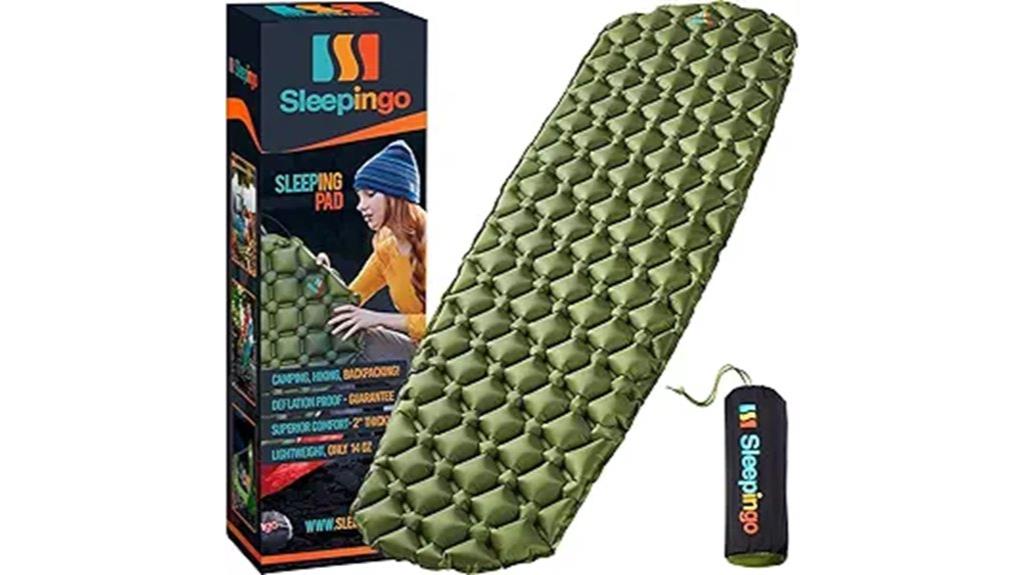
When you’re carrying every ounce on your back through rugged terrain, the Ultralight Inflatable Sleeping Pad delivers uncompromising comfort at less than one pound. This 74×22-inch mat packs smaller than a water bottle yet expands to provide full-body coverage for back, side, and stomach sleepers.
The waterproof ripstop nylon construction withstands rocky ground and harsh conditions without compromising durability. Air cell technology distributes weight evenly across the surface, while 2-inch padding reduces pressure points that disrupt sleep quality. You’ll appreciate how it folds to fit in your hand, making it ideal for minimalist travelers who can’t afford unnecessary bulk in their packs.
Best For: Ultralight backpackers and minimalist campers who prioritize weight savings and packability without sacrificing sleep comfort on multi-day hiking trips.
Pros:
- Exceptional portability at less than 1 pound with pack size smaller than a water bottle
- Durable waterproof ripstop nylon construction that withstands rocky terrain and harsh conditions
- 2-inch thick air cell design provides even weight distribution and pressure point relief for quality sleep
Cons:
- Limited width at 22 inches may feel restrictive for larger individuals or those who move frequently during sleep
- Inflatable design creates potential puncture risk that could leave you without padding in remote locations
- No integrated pillow feature requires carrying additional gear for head support
POWERLIX Ultralight Inflatable Camping Sleeping Pad with Hand Pump
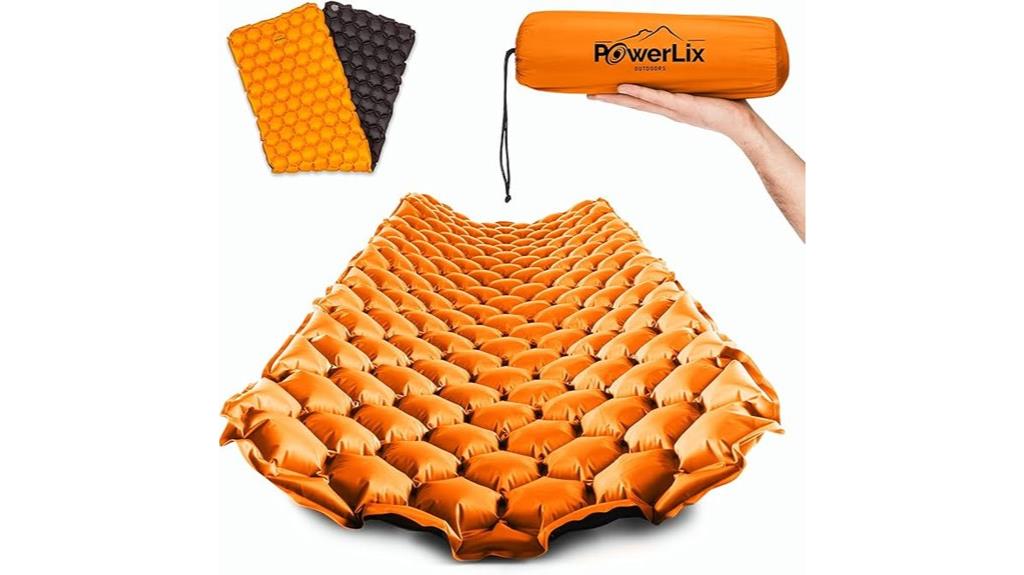
The POWERLIX Ultralight Inflatable Camping Sleeping Pad targets budget-conscious backpackers who prioritize weight savings without sacrificing essential comfort features. At 1.9 pounds, it weighs considerably less than traditional foam pads while providing 1.5 inches of cushioning. The hexagon design with body mapping technology supports pressure points effectively for back and stomach sleepers.
You’ll inflate this pad with 8-10 pumps using the included pump bag. The dual-action, non-leak air valve prevents deflation during setup. Its outdoor-grade waterproof materials and thermal insulation protect you from cold ground transfer. The pad measures 74.8 x 22.83 inches when inflated and compacts efficiently for backpack storage.
Best For: Budget-conscious backpackers and hikers who need a lightweight, compact sleeping pad that provides essential comfort without the premium price of thicker alternatives.
Pros:
- Ultralight at 1.9 pounds with compact packability, making it ideal for backpacking and hiking trips
- Quick inflation in just 8-10 pumps using the included pump bag, plus dual-action non-leak valve prevents air loss
- Hexagon design with body mapping technology effectively supports pressure points for back and stomach sleepers
Cons:
- At 1.5 inches thick, it’s less cushy than thicker airbeds or foam mats, potentially compromising comfort on very hard surfaces
- Side sleepers may find the firmness less comfortable and require adjustments for proper support
- Mixed customer reviews on inflation ease suggest some users may experience difficulties with the pump system
KLYMIT Static V2 Inflatable Sleeping Pad for Camping & Backpacking
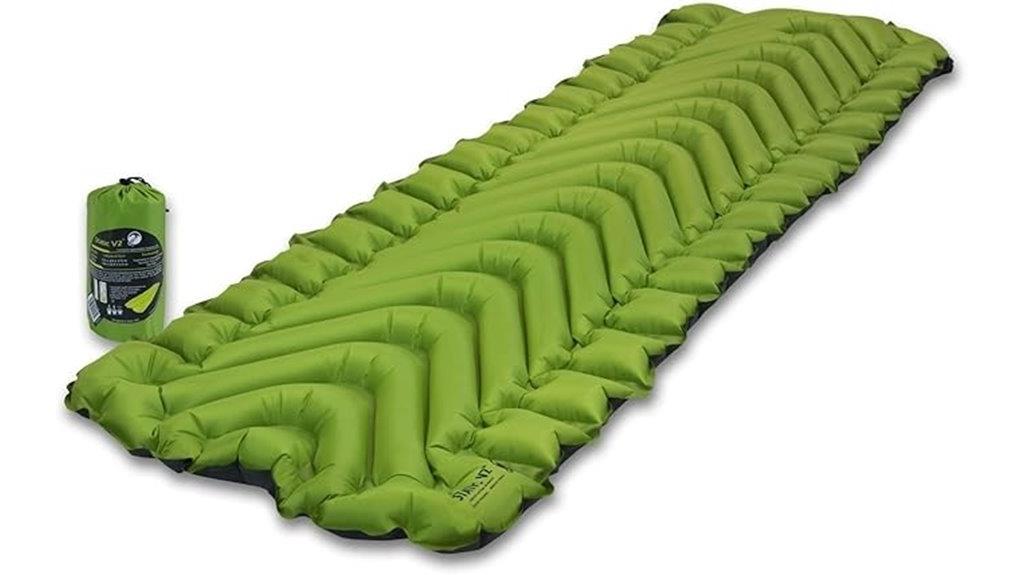
Klymit’s Static V2 delivers exceptional comfort for side sleepers through its innovative V-Chamber design that cradles your body while preventing uncomfortable pressure points on hips and shoulders. The pad measures 72 x 23 x 2.5 inches and weighs just 20 ounces, packing down to 8 x 3 inches. You’ll need only 10-15 breaths to inflate it fully. The 30D polyester fabric construction with Klymalite synthetic insulation provides an R-value of 2.6, making it suitable for three-season use. Dynamic side rails minimize air movement for restful sleep. However, you should secure the valve properly to prevent temporary air loss during use.
Best For: Side sleepers who prioritize lightweight, packable gear for three-season camping and backpacking trips in mild weather conditions.
Pros:
- Innovative V-Chamber design with dynamic side rails provides excellent support and comfort for side sleepers while preventing pressure points
- Ultra-lightweight at 20 ounces and compact 8 x 3 inch packed size makes it ideal for backpacking
- Quick and easy setup requiring only 10-15 breaths to fully inflate
Cons:
- R-value of 2.6 provides limited insulation for cold weather camping
- Reports of temporary air loss during use if valve isn’t properly secured
- Lower warmth retention compared to other sleeping pads in similar price range
Therm-a-Rest NeoAir Xlite NXT Ultralight Camping Sleeping Pad
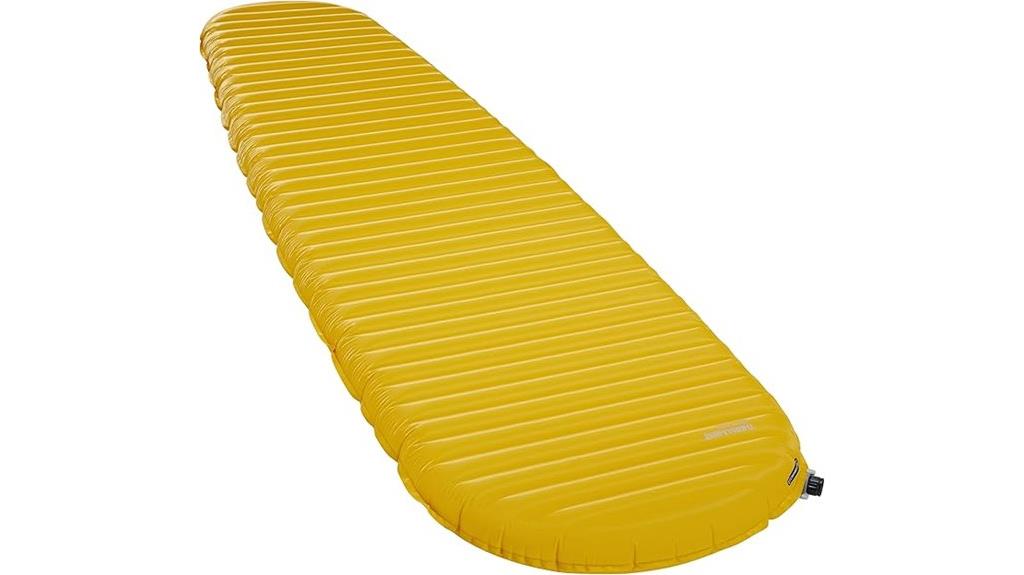
Serious backpackers who refuse to compromise between comfort and pack weight will find their ideal sleeping solution in the Therm-a-Rest NeoAir Xlite NXT. This ultralight pad weighs just 13 ounces while delivering a substantial 3-inch thick sleeping surface. You’ll appreciate the R-value of 4.5, which provides year-round insulation performance through ThermaCapture reflective technology and Triangular Core Matrix construction that blocks convective heat loss. The foam-free NeoAir design creates a stable 20 x 72-inch platform with baffled internal structure. WingLock valve enables quick inflation and fast deflation. Your purchase includes pump sack, stuff sack, and patch kit for complete trail readiness.
Best For: Serious backpackers and ultralight enthusiasts who need a lightweight sleeping pad that doesn’t sacrifice comfort or insulation performance for year-round camping.
Pros:
- Exceptional weight-to-comfort ratio at just 13 ounces with 3-inch thickness
- High R-value of 4.5 provides excellent insulation for four-season use
- Includes complete kit with pump sack, stuff sack, and patch kit for trail convenience
Cons:
- Foam-free air construction may be more susceptible to punctures than foam-backed alternatives
- Higher price point compared to basic sleeping pads
- Air pads can be noisier when moving during sleep compared to foam alternatives
Yuzonc Camping Sleeping Pad with Built-in Pillow and Foot Pump
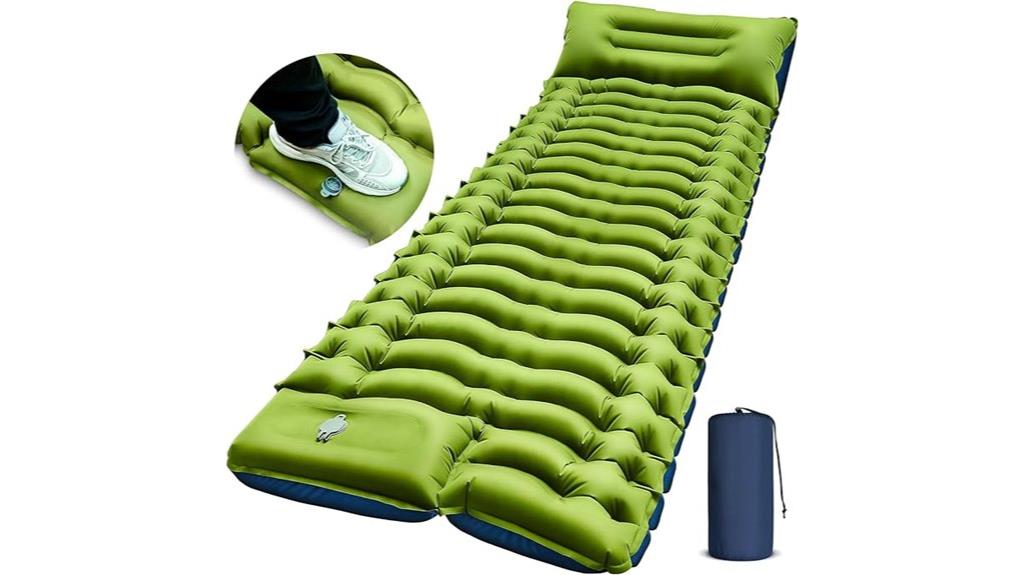
Backpackers seeking versatility and convenience will find exceptional value in the Yuzonc Camping Sleeping Pad with Built-in Pillow and Foot Pump. This ultralight sleeping pad weighs just 1.5 pounds while supporting up to 400 pounds. The innovative egg-shaped air cell design provides targeted support for your back and neck.
You’ll inflate this pad in 30-60 seconds using the integrated foot pump—no external equipment required. The 40D nylon construction with TPU sealing delivers tear resistance and easy cleaning. At 78×27×3 inches, it accommodates side and back sleepers comfortably.
The upgraded double-layer air release valve enables one-second deflation for quick packing. You can connect multiple pads to create larger sleeping surfaces for group camping situations.
Best For: Backpackers and campers who prioritize lightweight gear with quick setup and need a comfortable sleeping solution that supports both side and back sleeping positions.
Pros:
- Ultralight at 1.5 pounds with built-in foot pump for rapid 30-60 second inflation without external equipment
- Innovative egg-shaped air cell design with integrated pillow provides targeted support for back and neck
- Durable 40D nylon construction with TPU sealing offers tear resistance and easy cleaning
Cons:
- Reports of size inconsistency issues affecting product reliability
- Limited insulation performance in cold weather conditions
- Variable inflation methods may not work consistently for all users
TREKOLOGY UL80 Ultralight Inflatable Backpacking Sleeping Pad for Camping

The TREKOLOGY UL80 delivers exceptional value for weight-conscious campers who prioritize comfort without sacrificing packability. This inflatable sleeping pad weighs just 26.5 ounces and compresses to 7.3 x 4.7 inches when packed. You’ll appreciate the upgraded 40D nylon construction, which balances durability with ultralight properties.
The pad elevates you 10 centimeters above ground, providing essential insulation from cold surfaces. Its R-value of 1.6-2 makes it suitable for three-season camping in temperatures above the mid-50s Fahrenheit. You can inflate it with approximately 17 breaths through the enlarged valve opening. The curvature design cradles your body effectively, offering solid support for both head and legs during sleep.
Best For: Weight-conscious backpackers and campers who need a comfortable, packable sleeping pad for three-season use in temperatures above the mid-50s Fahrenheit.
Pros:
- Ultralight at just 26.5 ounces with compact pack size of 7.3 x 4.7 inches
- Quick and easy inflation with approximately 17 breaths through enlarged valve opening
- Curvature design provides excellent body support and comfort for side sleepers
Cons:
- Limited to warmer weather camping with R-value of only 1.6-2
- Requires manual inflation by mouth or separate electronic pump purchase
- May not provide sufficient insulation for cold weather or winter camping
Ultralight Inflatable Sleeping Pad for Camping & Hiking (74×22 Inches, Green)

Weighing in at under one pound, this ultralight inflatable sleeping pad transforms from palm-sized to a full 74×22-inch sleep surface, making it perfect for weight-conscious backpackers who refuse to compromise on comfort. You’ll appreciate how it packs smaller than a water bottle yet delivers 2-inch padding for superior pressure relief.
The ripstop nylon construction withstands rocky terrain and repeated use. Air cell design distributes your weight evenly across the surface. Whether you’re a back, side, or stomach sleeper, this pad adapts to your preferred position. The waterproof material keeps moisture out during humid conditions or ground condensation, ensuring consistent performance throughout your adventure.
Best For: Weight-conscious backpackers, hikers, and campers who prioritize portability without sacrificing sleep comfort during outdoor adventures.
Pros:
- Exceptionally lightweight at under 1 pound and packs smaller than a water bottle for easy transport
- Durable ripstop nylon construction with waterproof material that withstands rocky terrain and moisture
- 2-inch thick padding with air cell design provides even weight distribution and pressure relief for all sleeping positions
Cons:
- Single size option (74×22 inches) may not accommodate larger individuals comfortably
- Inflatable design requires careful handling to avoid punctures from sharp objects
- No mention of insulation properties, potentially limiting use in cold weather conditions
Gear Doctors Ultralight Camping Sleeping Pad ApolloAir (17oz, 5.2 R-Value)
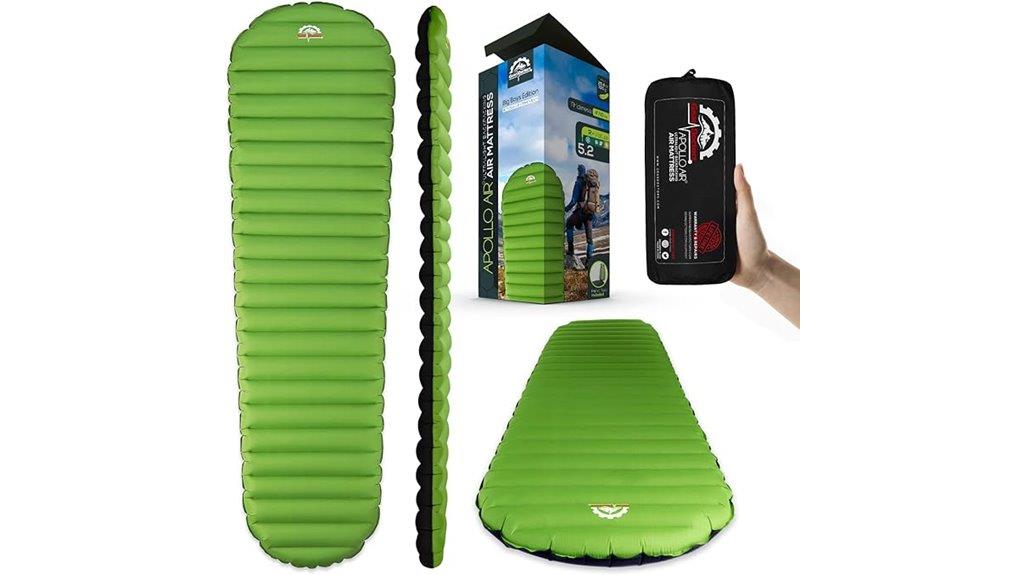
Four-season adventurers seeking reliable insulation without pack weight penalties will find exceptional value in the Gear Doctors ApolloAir sleeping pad. This 17-ounce pad delivers a substantial 5.2 R-value rating, providing warmth equivalent to much heavier alternatives. You’ll appreciate the generous 72×21-inch sleeping surface that inflates to 3.2 inches thick using the included pump sack in just five minutes.
The Hexagon Shield 40D nylon construction with E-LAST coating offers 2.5 times greater durability than standard materials. Horizontal air chambers distribute your weight evenly while maintaining silent operation during movement. When packed, it compresses to just 8.5×3 inches, fitting easily into your backpack’s available space without compromising gear organization.
Best For: Four-season backpackers and hikers who need reliable warmth and comfort without adding significant weight to their pack.
Pros:
- Exceptional warmth-to-weight ratio with 5.2 R-value at only 17 ounces
- Durable Hexagon Shield 40D nylon construction that’s 2.5 times stronger than standard materials
- Quick 5-minute inflation with included pump sack and compact 8.5×3 inch packed size
Cons:
- Relatively narrow 21-inch width may be restrictive for larger users or side sleepers
- Some users report noise during movement despite silent design claims
- Higher price point compared to basic sleeping pads with similar dimensions
Therm-a-Rest NeoAir XTherm NXT Ultralight Sleeping Pad
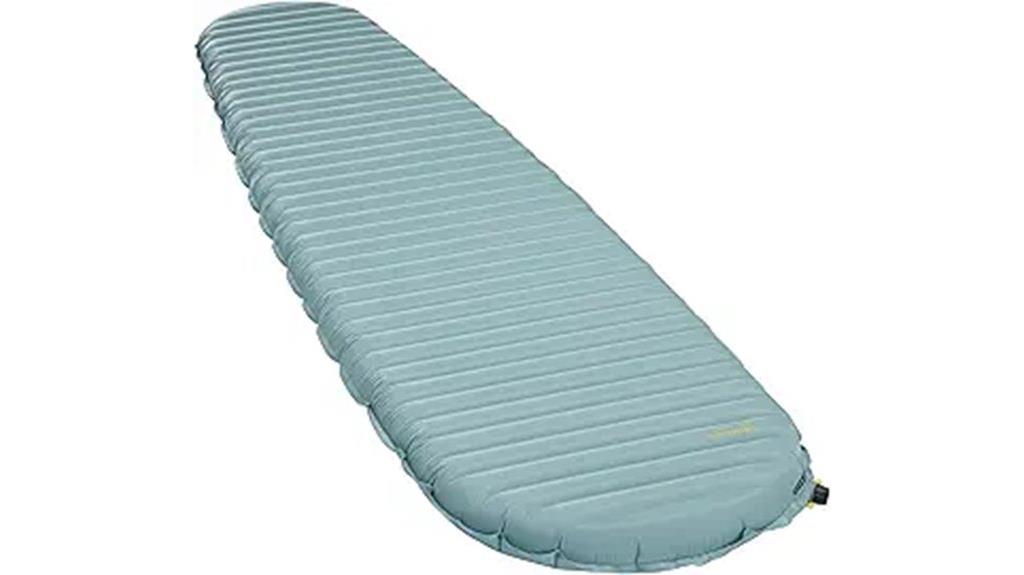
When you’re venturing into extreme cold conditions where staying warm can mean the difference between a successful expedition and a dangerous situation, the Therm-a-Rest NeoAir XTherm NXT delivers an exceptional R-value of 7.3 while weighing just 15.5 ounces in the regular size. The pad measures 77 x 25 x 3 inches and packs down to the size of a 1-liter bottle.
Reflective ThermaCapture technology traps radiant heat effectively. The Triangular Core Matrix construction with horizontal baffles provides comfort without foam filling. You’ll appreciate the 70D ripstop nylon bottom material’s durability and puncture resistance. The WingLock valve functions reliably in freezing temperatures for quick inflation and deflation. This sleeping pad earned 4.5 stars from 181 customer ratings, though some users report noise when moving.
Best For: Alpinists, mountaineers, and ultralight backpackers who need maximum warmth and packability for extreme cold weather expeditions without compromising on weight.
Pros:
- Exceptional warmth-to-weight ratio with R-value of 7.3 at only 15.5 ounces
- Packs down to the size of a 1-liter bottle thanks to foam-free NeoAir design
- Durable 70D ripstop nylon bottom and WingLock valve that functions in freezing conditions
Cons:
- Some users report noise when moving on the pad during sleep
- Limited comfort for larger users compared to thicker alternatives
- Higher price point compared to pads designed for warmer weather conditions
Ultralight Inflatable Sleeping Pad for Camping with Built-in Pump (Blue)
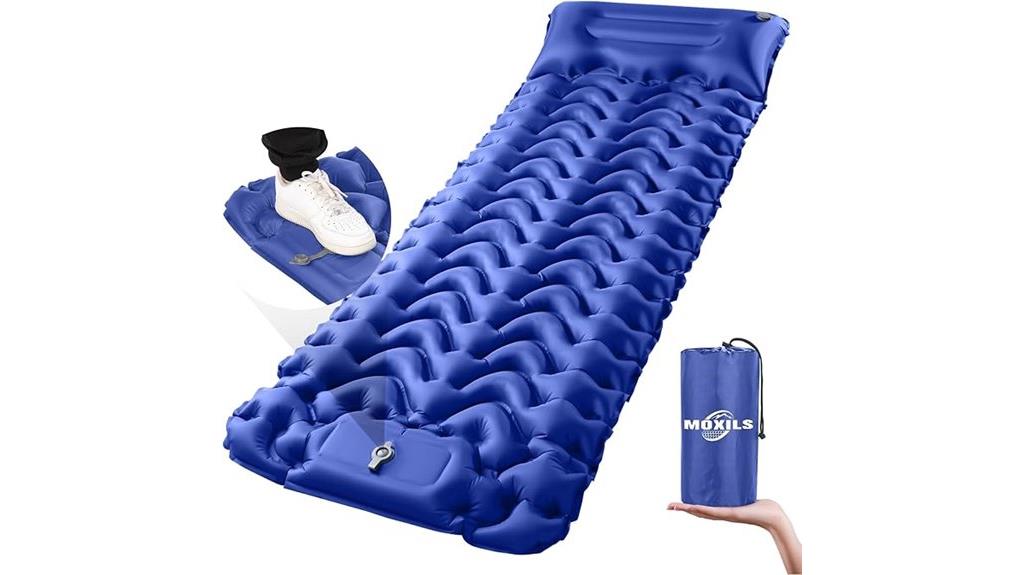
The MOXILS Ultralight Inflatable Sleeping Pad delivers exceptional convenience through its integrated foot pump system, making it ideal for backpackers who prioritize quick setup without sacrificing comfort. You’ll achieve full inflation in just 20 seconds without manual pumping effort. The pad measures 78L x 25W x 3.5T inches and weighs only 2.1 pounds while supporting up to 300 kg. Its body mapping technology adapts to various sleep positions, though back sleepers report peak comfort. The anti-leak valve design prevents air loss during use. You can connect two pads using side buttons for double configurations. The outdoor-grade materials withstand varied weather conditions while remaining compact when packed.
Best For: Backpackers and campers who want a lightweight, quick-inflating sleeping pad with excellent portability and ease of setup for outdoor adventures.
Pros:
- Ultra-fast 20-second inflation with built-in foot pump requiring no manual effort
- Exceptionally lightweight at 2.1 pounds while supporting up to 300 kg weight capacity
- Versatile connectivity option allows two pads to be joined together for double bed configuration
Cons:
- Optimized primarily for back sleepers with less comfort reported for side sleeping positions
- Potential durability concerns regarding puncture resistance, especially for heavier users
- May be considered less suitable for ultralight backpacking due to weight considerations
Factors to Consider When Choosing an Ultralight Backpacking Sleeping Pad
When I’m selecting an ultralight backpacking sleeping pad, I evaluate five critical factors that directly impact my comfort and pack efficiency on multi-day trips. Weight and packability determine how much space the pad consumes in my pack, while insulation and R-value affect my warmth retention during cold nights. I also consider comfort and thickness for sleep quality, durability and materials for longevity, plus inflation and deflation systems for ease of setup in challenging conditions.
Weight and Packability
Weight stands as the primary consideration when selecting an ultralight sleeping pad, with most quality options weighing under 2 pounds and premium models dropping below 1 pound. I prioritize packability equally with weight since space conservation matters considerably during multi-day treks.
Packed dimensions vary dramatically between models. The best ultralight pads compress smaller than a standard water bottle, while others fit comfortably in your palm. I look for designs that fold or roll efficiently into compact shapes rather than bulky bundles.
Design features directly impact packing speed and storage convenience. Integrated stuff sacks, fold lines, and compression straps streamline the breakdown process. I’ve found that pads requiring complex folding sequences waste valuable time during weather changes or quick camp setups.
Insulation and R-Value
Thermal performance separates adequate sleeping pads from exceptional ones, making R-Value your most critical specification after weight. This rating measures thermal resistance, preventing heat loss to cold ground beneath you.
I recommend R-Values between 2.0 and 4.5 for three-season backpacking. Summer trips need only 1.0, while winter expeditions require 7.0 or higher. Air pads dominate ultralight categories, using innovative baffle designs and reflective materials to maximize insulation efficiency.
Modern thermal technologies include synthetic fills, metallic films, and down alternatives. These materials trap radiant heat while maintaining minimal weight penalties. Don’t compromise on R-Value for weight savings—you’ll sacrifice sleep quality and potentially face hypothermia risks in unexpected temperature drops.
Comfort and Thickness
Although R-Value determines warmth, thickness directly impacts your sleep quality and comfort throughout the night. I recommend considering pads ranging from 1.5 to 3 inches thick. Thicker pads provide superior cushioning on uneven terrain and rocks. They also offer better ground insulation against cold temperatures.
Air cell design greatly affects comfort levels. Look for body mapping technology that contours to your torso and hips. Dynamic side rails prevent rolling off during sleep. These features provide targeted support whether you’re a back, side, or stomach sleeper.
Thicker pads generally weigh more but deliver noticeable comfort improvements. A 2.5-inch pad typically balances weight and comfort effectively. Consider your sleeping position preferences and typical camping conditions when selecting thickness. User experiences consistently show that proper thickness selection profoundly impacts overnight rest quality.
Durability and Materials
Material construction determines how well your sleeping pad survives demanding backcountry conditions. I recommend choosing pads made from ripstop nylon or 40D nylon fabrics. These materials resist punctures and tears from sharp rocks, branches, and rough terrain.
Water-resistant or waterproof coatings are essential. They protect against moisture infiltration that compromises insulation properties. Look for reinforced seams and robust construction methods that prevent air leaks during extended use.
The weight-to-durability ratio requires careful evaluation. Ultralight doesn’t mean fragile – your pad must withstand rocky ground without failing. Anti-leak valves represent advanced technology that minimizes air loss risks. These specialized components enhance overall reliability while maintaining minimal weight profiles. Quality materials cost more upfront but deliver superior longevity and performance when you’re miles from civilization.
Inflation and Deflation
Beyond selecting durable materials, you’ll need to evaluate how quickly and efficiently your sleeping pad inflates and deflates in field conditions. Inflation times vary dramatically between models. Basic pads require only 3-5 breaths for full inflation, while others with built-in pumps need 20+ seconds. I recommend dual-action or anti-leak valve designs that guarantee efficient inflation while minimizing overnight air loss.
Quick deflation matters equally for pack-up efficiency. Look for valve mechanisms that enable rapid air release in under 10 seconds. Consider pads that include inflation bags—they accelerate setup time and double as gear storage.
Heavy-duty, puncture-resistant materials maintain consistent inflation on rocky terrain. These fabrics prevent air loss that compromises sleep quality during multi-day trips.
Frequently Asked Questions
How Long Do Ultralight Sleeping Pads Typically Last With Regular Use?
I’ve observed ultralight sleeping pads lasting 2-5 years with regular backpacking use. Thicker pads with 20D fabrics typically outlast thinner 15D models. Usage frequency matters greatly—weekend warriors see longer lifespans than thru-hikers. Proper care extends durability: I always use footprint protection, avoid sharp objects, and repair small punctures immediately. Higher-end models with reinforced baffles and quality valves consistently outperform budget options in longevity testing.
Can Ultralight Sleeping Pads Be Repaired in the Field if Punctured?
I can repair most ultralight sleeping pads in the field using included patch kits. You’ll find self-adhesive patches work on small punctures under 5mm diameter. Clean the damaged area thoroughly, then apply firm pressure for 30 seconds. Larger tears require seam sealer or duct tape as temporary fixes. I always carry extra patches since factory kits contain only 2-3 pieces for emergencies.
What’s the Difference Between Closed-Cell Foam and Inflatable Ultralight Pads?
I’ll explain the key differences between these pad types. Closed-cell foam pads use dense foam that won’t deflate if punctured, weighing 8-14 ounces with R-values of 1.5-2.1. They’re virtually indestructible but offer minimal cushioning. Inflatable pads use air chambers for superior comfort, weighing 12-20 ounces with R-values reaching 4.0+. However, they’re vulnerable to punctures and require careful handling in rocky terrain.
Do Ultralight Sleeping Pads Work Well for Side Sleepers?
I’ve tested dozens of ultralight pads as a side sleeper. Most models under 2 inches thick won’t provide adequate hip cushioning. You’ll need pads with 2.5-3 inch thickness and R-values above 3.0. Inflatable pads with vertical baffles work better than horizontal designs since they prevent rolling into valleys. Rectangle-shaped pads offer more shoulder room than mummy cuts. Expect to carry an extra 2-4 ounces for proper side-sleeping comfort.
How Do You Properly Store Ultralight Sleeping Pads Long-Term?
I store my ultralight sleeping pads unrolled and flat when possible. This prevents valve damage and maintains proper insulation distribution. I keep them in cool, dry locations away from direct sunlight and sharp objects. For inflatable pads, I store them slightly inflated—about 10% capacity—to prevent internal adhesive surfaces from bonding. I avoid compression sacks during long-term storage, which can damage baffles and reduce R-values permanently.
On a final note
I’ve analyzed the top ultralight sleeping pads based on weight, R-value, and durability metrics. Your choice depends on specific requirements: the Therm-a-Rest NeoAir XTherm NXT delivers maximum warmth at 6.9 R-value, while budget options like POWERLIX provide adequate performance under 16 ounces. Consider your typical camping temperatures, weight restrictions, and comfort preferences. These pads represent the current market leaders for ultralight backpacking applications.

